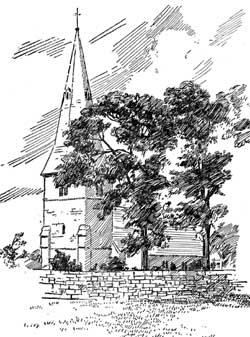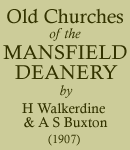< Previous | Contents | Next >
Kirkby-in-Ashfield

St. Wilfrid's, Kirkby-in-Ashfield.
JANUARY 16th, 1907, will ever be a memorable day in the history of Kirkby-in-Ashfield and its church. Shortly before midnight a fire broke out in the organ chamber and before the flames could be extinguished, nearly all trace of the old church had disappeared. It was a sad blow to churchmen in all parts of the county. The north nave arcade, dating back to the days of Henry II., beautiful examples of the stained-glass worker's art, old brasses, handsomely carved mural tablets were all destroyed. Never shall we forget the picture of desolation the church presented on the morning following. With the exception of a few charred rafters at the tower end of the nave there was no sign of the roof, which had covered chancel and nave. Every foot of glass had gone, and not a vestige of the organ, altar, or pulpit remained. Mural tablets lay smashed among the debris. But a few weeks before we had seen the monumental masons fixing a handsome tablet to the memory of the Rev. Thomas Woodman, who for 33 years was curate and rector of the parish; this, like others, was destroyed. We looked, in vain, for the FitzRandolph brass, which archaeologists prized so highly. Practically all that was of historical and antiquarian value in the edifice was consumed in the fire. Memories hallowed and sacred cling to the dear old parish church, and the severance of ties that bound the past to the present was a severe blow to the parishioners. In the early and mediaeval ages the church had a real and vital connection with the life of the village, for it was used not only as a place of worship and prayer but, according to the necessities of the time, as parochial fortress, public school, parish hall, and even as the ale-house, dancing hall, stable and store. It is this knowledge added to the interesting architectural features of our old village churches which intensifies the feeling of regret when fire destroys one. St. Wilfrid's tapering spire will still look across the Derbyshire valley from its eminence, for the fire did not raze this to the ground, fortunately, although some part of the tower was damaged. This, however, is not the place to dwell unduly upon the conflagration and its consequences, but an article dealing with the history of the church would be very incomplete without some extended reference to it. We were in the church taking particulars of the architectural features but a short time before the edifice was destroyed, and our contribution to this series, dealing with the church was written before the fire had destroyed the building. With the exception of slight alterations we have decided to have the article printed as written, so that those interested in the church may have a record of its contents and architectural features, prior to the date mentioned.
The Domesday survey states that at Cherchbi there is a church and a priest and two mills of 3 shillings, and 3 acres of meadow, wood pasture, here and there, two miles long and one broad, value in King Edward's time £4, now £3.
In 1311 the Prior and Canons of Felley appeared in the church of Southwell before the official Archdeacon of Nottingham, and humbly besought him that the ancient evidences of their charter of endowment whilst they were yet perfect, might be published and recorded whereby he cited, Thomas, rector of the church of Kirkby, with others to appear before him to show cause of objection if they had any. A John de Kirkby was elected Prior of Felley in 1328.
Whilst not desiring to encroach upon the manorial history of Kirkby, we might state that prior to 1339 the manor was held by a payment of yearly rent of 40s. to buy wine and 6s. 8d., or a quart of wheat, at that price, to make wafers to celebrate the Eucharist in the Church of St. Mary at Newstead. The Close Rolls of 1323 have a note that Thos. Wake was ordered to pay 40s. to the Newstead arrears from the manor of Kirkby, which belonged to John de Stottevill. The parson of Kirkby was not the only transgressor of Forest Laws, for on the Patent Rolls of Edward I. is the following: 1280, Oct. 24, Westminster—Pardon to Nicholos del Ille, of Kirkby-in-Ashfield for taking a stag in the wood of Bolewell within the forest of Shirewode. The Forest laws were in force in 1318, and we find Kirkby's rector breaking them: Robert de Kirkby, rector of Kirkby was fined 3d. for appropriating a dry stut from the Forest (White's Dukeries Records).
Edward I. was at Kirkby on Feb. 18 and 19, 1293, and from there he passed on to Codnor Park.
The Patent Rolls, 1295, Dec. 1, has the following: Westminster. Protection with clause volumus until Michaelmas for the following who, like the rest of the clergy, have granted the King, a tenth of their benefices as above,—Thomas de Perers, parson of the church of Kyrkeby-in-Ashfield.
From the same source we learn that in 1311 John de Hotham was presented to the living upon the resignation of the above-named rector "in the King's gift by reason of the lands of Eleanor de Genevre, deceased, tenant in chief, being in his hands."
The 1650 Parliamentary survey records:— The Rectory or parsonage of Kirkby-in-Ashfield is worth £100. "John Hoyland, clerke, the present incumbent who hath the cure of soules there and receives the profitte thereof to his own use being a preachinge minister."
There was a time, and not so long ago as many people perhaps imagine, when Kirkby-in-Ashfield, as a village, practically extended from the old cross to the more ancient church of St. Wilfrid only. As a parish it is, in area, a very wide one, but generally speaking the old village clustered round the church which, perched on a ridge, dominates the valley looking to the south-west. This is old Kirkby, or Kirkby-in-Ashfield proper. Colliery developments, coupled with the fact that the railway passes through the parish, has tended to the growth of the village at the end nearer the Midland Railway Company's station and today we see a large and prosperous community living at what was once known as Kirkby Folly, now more euphoniously named East Kirkby with a new and commodious church of its own. At Kirkby Woodhouse, too a church has recently been erected.
